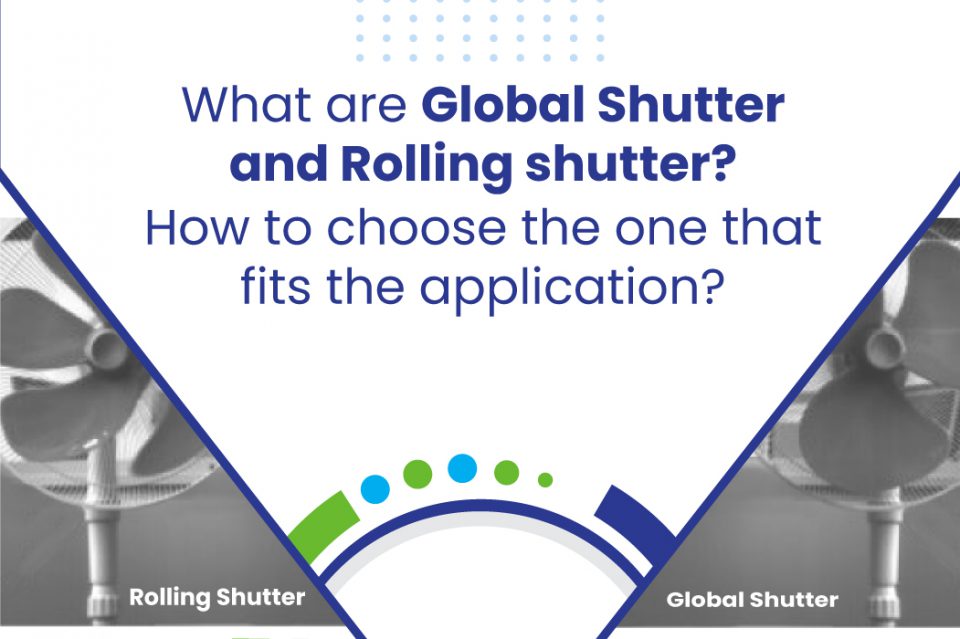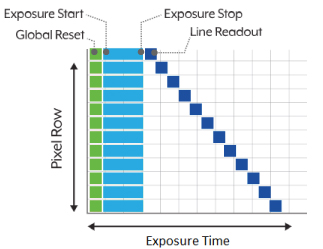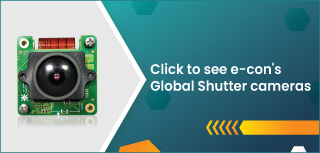Today’s modern embedded vision systems have sensors that capture and record images for various processing and analysis purposes. These sensors use an electronic shutter to capture images. An electronic shutter is a device that controls the exposure of photon wells on the sensor. It also determines whether the pixels are exposed line by line or as a complete matrix.
Let’s discover the differences between global shutter and rolling shutter, their pros and cons, and how to choose which one you need.
How the Shutter Mechanism Works
But first, let’s explore shutter mechanisms and how they work.
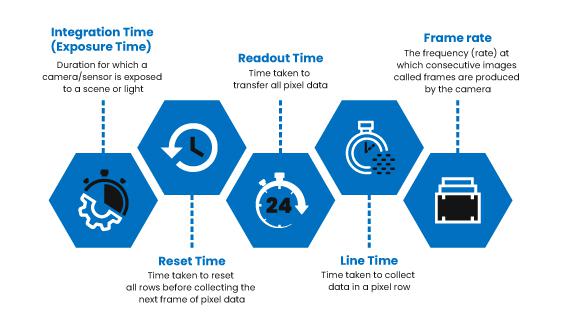
What is Global Shutter?
In the global shutter mode of an image sensor, every pixel on the sensor starts and concludes its exposure simultaneously within the programmed exposure duration during each image acquisition cycle. Upon the completion of the exposure period, the process of reading out pixel data commences systematically, row by row, until all pixel data has been extracted.
This mechanism is inherent in global shutter cameras; ensuring the capture of non-distorted images devoid of wobble or skewing artifacts. That’s why these sensors are used in embedded vision applications that require accurate imaging of high-speed moving objects.
For instance, a 640 x 480 resolution image is taken. When it’s exposed to global shutter, all the 307200 (640 x 480) sensor pixels are exposed simultaneously for the programmed exposure period.
Explore: e-con Systems’ Global Shutter Cameras
Global shutter is capable of avoiding rolling shutter artifacts alone, not motion blur caused by fast-moving objects and exposure. Only at lower exposure levels does global shutter help capture sharp images of moving objects without any motion blur.
What is Rolling shutter?
The rolling shutter mode in a camera sequentially exposes the pixel rows with a temporal offset between each row, differing from the simultaneous exposure of global shutter cameras. Initially, the first row of pixels begins capturing light, completing its exposure cycle before the next row begins.
This approach leads to a temporal delay between the start and end times of light collection for each subsequent row. However, the duration of the light collection remains consistent across all pixel rows, ensuring uniform exposure times despite the staggered readout. Such temporal offset influences image quality, often resulting in artifacts like skew or wobble during the capture of high-speed motion or when the camera itself moves rapidly.
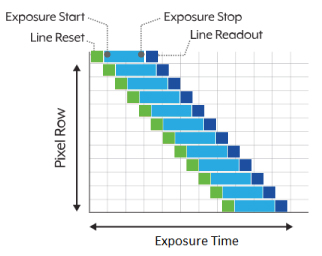
Explore: e-con Systems’ Rolling Shutter Cameras
For instance, in a rolling shutter for a 640 x 480 resolution image, the topmost of 480 pixel rows is exposed first followed by the consecutive rows.
What is the Rolling Shutter Effect?
The difference in imaging between the rolling shutter sensor and the global shutter sensor is predominantly reflected in dynamic image acquisition. When a rolling shutter sensor captures fast-moving objects, the rolling shutter effect occurs.
In rolling shutter, all pixels of the array in the image sensor are not exposed simultaneously, and each row of sensor pixels is scanned sequentially. Due to this, if an object moves faster than the exposure time and readout time of the image sensor, the image gets distorted owing to rolling light exposure. This is called the rolling shutter effect.
Rolling shutter effect when capturing rotating objects
While capturing high-speed rotating objects in rolling shutter mode, distortion and shutter artifacts occur easily, as shown in the image below.
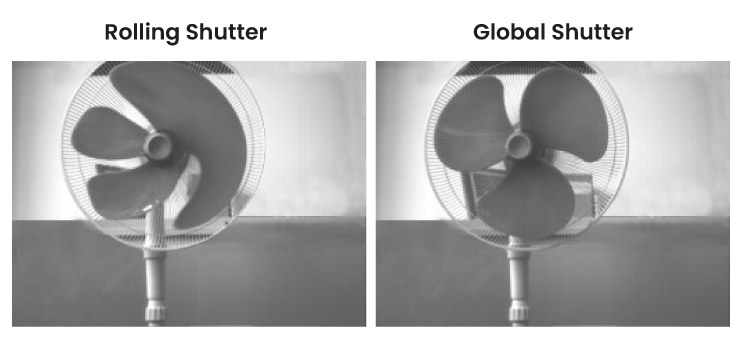
In the above comparison, the image taken in global shutter mode captures the shape of the fan blade perfectly, while it is deformed in rolling shutter mode.
Rolling shutter effect when capturing linear moving objects
In rolling shutter mode, distortion and shutter artifacts occur when capturing high-speed moving objects, as shown in the image below.
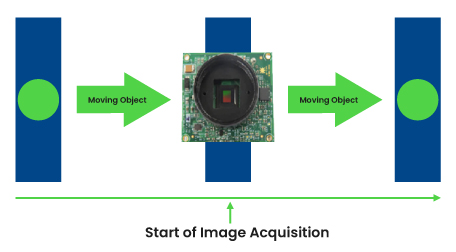
In the above comparison, the object moving in a linear direction from left to right captured at global shutter mode perfectly restores its shape. The image captured at rolling shutter mode creates rolling shutter effects in the form of horizontal blur.
Pros and Cons of Global Shutter and Rolling Shutter Cameras
| PROS | CONS |
|
1. Capturing fast-moving objects: As earlier mentioned, the global shutter exposes all pixels simultaneously, enabling it to capture high-speed motion without motion artifacts like skew or wobble. 2. Minimal image distortion: The simultaneous pixel exposure reduces motion-related image distortions, enabling accurate imaging of objects in rapid movement. 3. Effective multi-camera synchronization: Global shutter cameras ensure uniform synchronization across multiple cameras, which is crucial for industrial inspection, 3D scanning, etc. |
1. Higher ambient noise: Global shutter sensors can have higher ambient noise compared to rolling shutter sensors due to their architecture and simultaneous exposure. 2. High sensor cost: The manufacturing complexity of global shutter sensors results in higher production costs, making them more expensive compared to rolling shutter sensors. 3. Lower light sensitivity: The additional circuitry required for simultaneous pixel exposure often reduces the fill factor, leading to a decrease in light sensitivity. |
| PROS | CONS |
|
1. Lower ambient noise: Rolling shutter sensors have a simpler architecture, leading to reduced electronic noise. 2. Lower sensor cost: The simpler design makes rolling shutter sensors easier and less expensive to manufacture, resulting in lower production costs. 3. Higher light sensitivity: Rolling shutter sensors generally have a higher fill factor, which means they capture more light and offer better low-light performance. |
1. Image distortion: Since rows are exposed sequentially, rolling shutter sensors are prone to artifacts like skew, wobble, etc., when capturing fast-moving objects. 2. Potential for flicker: Rolling shutters can struggle with flicker artifacts when shooting under artificial light sources. 3. Limited synchronization capabilities: Rolling shutter sensors are less suited to precise synchronization across multiple cameras. |
Global Shutter or Rolling Shutter: Which Camera Do You Need?
A global shutter camera is mainly used for capturing high-speed moving objects without artifacts and motion blur. Global shutter cameras are used in applications such as ball tracking, industrial automation, warehouse robots, drones, live cell imaging, etc.
Rolling shutter sensors offer excellent sensitivity for imaging and can be used for cost effective applications. It is predominantly used for capturing slow-moving objects such as agriculture tractors, slow speed conveyors, and standalone applications like kiosks, barcode scanners, etc.
e-con Systems Offers World-Class Global Shutter and Rolling Shutter Cameras
e-con Systems, with 20+ years of experience in designing, developing, and manufacturing OEM solutions, offers state-of-the-art global shutter and rolling shutter cameras. Our global shutter cameras effortlessly capture fast-moving subjects without distortion. On the other hand, our rolling shutter cameras deliver superior image quality, catering to applications that demand high sensitivity and noise reduction, especially in low-light environments.
e-con Systems ensures that customers can choose the most suitable camera to meet their unique needs.
See all our Rolling Shutter Cameras
See all our Global Shutter Cameras
Visit our Camera Selector Page to browse our complete range of camera solutions.
If you need any help integrating the right camera into your embedded vision systems, please write to camerasolutions@e-consystems.com.

Rathish, Our tech support expert with rich 6+ years of experience. He has been a key person in addressing and solving crucial technical queries with wide range of scenarios related to OEM camera hardware and software.


